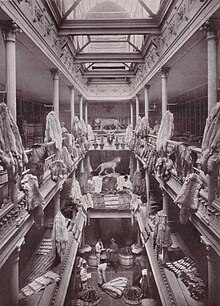Tobacco products
Tobacco goods , in Austria also rough goods , are prepared , tanned animal skins that have not yet been processed into fur . The term is used particularly in the fur trade itself; the singular form "Rauchgut" is not very common.
Origin of name
The name is derived from the adjective "smoke, rough / rough", which means something like "hairy, shaggy". The expression can be traced back to this meaning from the 16th century, e.g. B. in the fairy tale Allerleirauh . In its actual meaning at that time, Allerleirauh is a piece of fur composed of different types of fur, which was used for fur lining and as a trimming on the outside . Krünitz encyclopedia from 1812 noted under "Rauch": "Overgrown with wool, hair or feathers, in contrast too smooth."
In older times there was no strict distinction between tobacco products and fur products. It was only later that attempts were made to separate these two terms.
use
A coat with thick, not tightly fitting hair is called "smoke" in the trade. The Kürschner technical language also knows quality terms such as over smoke, full smoke, half smoke, little smoke (somewhat flat) and no smoke (flat). These gradations, which can be further nuanced, designate "the condition of hair growth during peeling in relation to the condition of full maturity within one and the same species". The umbrella term for the description of the hair condition is "smoke".
Tobacco products are the subject of a worldwide trade, tobacco products or in common parlance also called fur trade. Tobacco dealers, formerly also smoke dealers, Austrian rough goods dealers, is the corresponding job title for employees in the wholesale industry.
The finishing of tobacco products , today also under the collective term tobacco products refinement , makes the skins durable and processable for the furrier. This processing is similar to the tannery , only that, in contrast to this, the hair of the animal fur is preserved during the dressing. The tobacco products thus represent the raw material for fur objects. These are sometimes still referred to as "smokers".
literature
- Bruno Schier : On the history of the word "Rauchware" (Technological Fur Subject Dictionary). CB-Verlag Carl Boldt, Berlin 1950, 11 pp.
See also
Individual evidence
- ↑ Reinhold Stephan, Bochum: On the history of the tobacco trade in antiquity and the Middle Ages and the development of the Russian-Asian region from 16.-18. Century . Inaugural dissertation University of Cologne 1940, p. 68. Table of contents . Secondary sources Konrad Bahr: Trade and traffic of the German Hanseatic League in Flanders during the 14th century . Leipzig 1911, pp. 139-143. J. Kulischer: General economic history of the Middle Ages and modern times . Munich, Berlin 1928/1929, 2 volumes. Russian Economic History , Vol. I, p. 276
- ↑ Reinhold Stephan, Bochum: On the history of the tobacco trade in antiquity and the Middle Ages and the development of the Russian-Asian region from 16.-18. Century . Inaugural dissertation University of Cologne 1940, p. 2
- ↑ Ss: Origin and meaning of the word Rauchware . In: Das Pelzgewerbe , Volume XX, New Series, No. 3, Hermelin-Verlag Dr. Paul Schöps, Berlin (et al.) 1970. pp. 29-30
- ↑ Heinrich Gottlieb Kreussler: History of the University of Leipzig: from its origin to our times. - In addition to a complete list of scholarships. CA Solbrig, Leipzig, 1810. Internet Archive, p. 170 (PDF file). Retrieved March 31, 2020.

